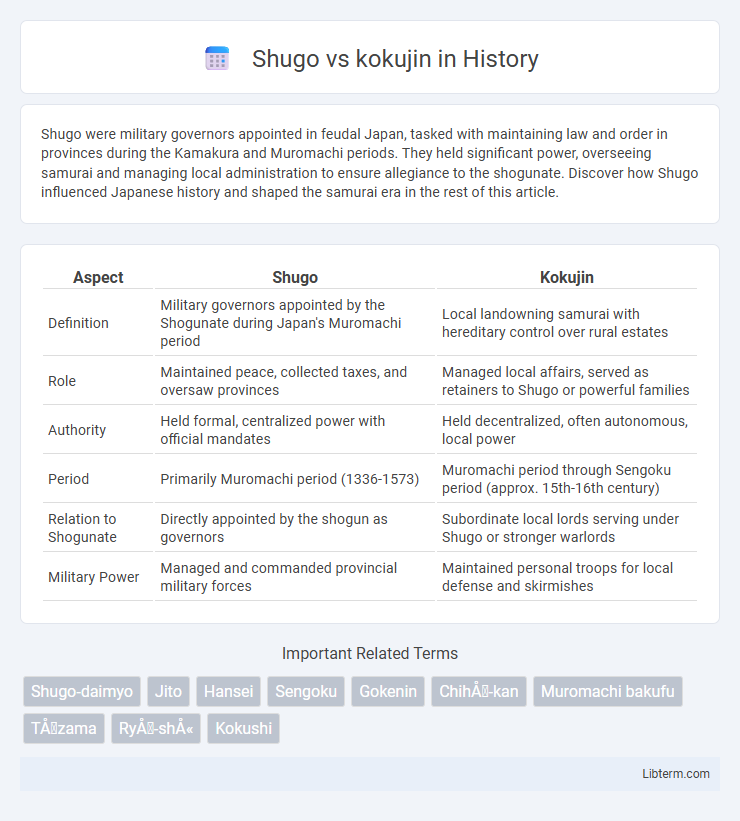Shugo were military governors appointed in feudal Japan, tasked with maintaining law and order in provinces during the Kamakura and Muromachi periods. They held significant power, overseeing samurai and managing local administration to ensure allegiance to the shogunate. Discover how Shugo influenced Japanese history and shaped the samurai era in the rest of this article.
Table of Comparison
| Aspect | Shugo | Kokujin |
|---|---|---|
| Definition | Military governors appointed by the Shogunate during Japan's Muromachi period | Local landowning samurai with hereditary control over rural estates |
| Role | Maintained peace, collected taxes, and oversaw provinces | Managed local affairs, served as retainers to Shugo or powerful families |
| Authority | Held formal, centralized power with official mandates | Held decentralized, often autonomous, local power |
| Period | Primarily Muromachi period (1336-1573) | Muromachi period through Sengoku period (approx. 15th-16th century) |
| Relation to Shogunate | Directly appointed by the shogun as governors | Subordinate local lords serving under Shugo or stronger warlords |
| Military Power | Managed and commanded provincial military forces | Maintained personal troops for local defense and skirmishes |
Introduction to Shugo and Kokujin
Shugo were military governors appointed by the Kamakura and Muromachi shogunates to maintain order and oversee provinces in medieval Japan, holding significant administrative and military power. Kokujin were local samurai landholders who managed estates and served as vassals to shugo, playing a crucial role in regional governance and military support. The relationship between shugo and kokujin shaped the political and social structure of feudal Japan, influencing power dynamics and territorial control.
Historical Background of Shugo
The Shugo were military governors established in 1185 during the Kamakura period to maintain order and oversee provinces on behalf of the shogunate. Typically drawn from powerful samurai families, the Shugo wielded political, military, and judicial authority, often controlling local law enforcement and tax collection. Their rise created tension with the Kokujin, local landowners who resisted Shugo dominance, leading to conflicts that shaped feudal Japan's power dynamics.
Historical Background of Kokujin
Kokujin were regional samurai landholders in medieval Japan who rose to power during the Kamakura and Muromachi periods, often serving under the shugo, provincial military governors appointed by the shogunate. They managed local territories and maintained militias, gradually increasing their autonomy and influence as the central authority weakened. The historical significance of kokujin lies in their role as intermediaries between the shogunate's political control and the local populace, contributing to the feudal fragmentation and eventual rise of warlord domains.
Differences in Social Status
Shugo were appointed military governors during Japan's Kamakura and Muromachi periods, holding official authority granted by the shogunate to oversee provinces and maintain order. Kokujin, on the other hand, were local samurai landowners who exercised power based on hereditary landholdings and regional influence without formal appointment from the central government. The key difference in social status lies in the shugo's role as centralized officials with administrative duties, while kokujin maintained localized control through personal and familial ties.
Roles and Responsibilities
Shugo were military governors appointed by the Kamakura shogunate to maintain law and order, oversee taxation, and manage local samurai forces, ensuring regional stability. Kokujin were local land-owning samurai who held smaller domains, responsible for defending their territories and supporting the shugo's authority. The shugo's broad administrative and military control contrasted with the kokujin's localized responsibilities and allegiance, creating a layered governance system in feudal Japan.
Political Influence of Shugo and Kokujin
Shugo were provincial military governors appointed by the Muromachi shogunate, wielding significant political influence through their control of samurai armies and administration of local law enforcement. Kokujin, as local landholding samurai, exercised power through managing agricultural production and maintaining regional stability, often challenging Shugo authority. The dynamic between Shugo and Kokujin shaped the decentralization of power during the Muromachi period, affecting the political landscape and governance of feudal Japan.
Military Powers and Authority
The Shugo wielded significant military authority as provincial governors appointed by the shogunate, commanding samurai armies and overseeing regional defense. Kokujin, local warrior elites, held autonomous power within their domains, maintaining private militias that often rivaled or collaborated with Shugo forces. Control over military resources and strategic fortifications allowed both entities to influence political stability and power dynamics in feudal Japan.
Relationship with the Central Government
The Shugo served as military governors appointed by the Kamakura shogunate, acting as direct representatives of the central government with authority to maintain order and collect taxes in provinces. In contrast, Kokujin were local landowners or samurai who held regional influence but lacked formal ties to the shogunate, often operating semi-autonomously from central control. This relationship positioned the Shugo as loyal agents enforcing shogunate policies, while the Kokujin balanced local interests and sometimes resisted centralized authority.
Conflicts and Cooperation between Shugo and Kokujin
Shugo, as provincial military governors during Japan's Muromachi period, often clashed with Kokujin, local samurai landowners, due to overlapping authority and territorial disputes. Despite frequent conflicts over land control and tax collection, Shugo and Kokujin occasionally cooperated to suppress peasant uprisings and external threats, maintaining regional stability. The complex relationship involved shifting alliances where Kokujin leveraged Shugo's military power to legitimize their local dominance while Shugo relied on Kokujin's knowledge of local affairs.
Legacy and Impact on Japanese Feudal Society
Shugo, as military governors appointed by the Ashikaga shogunate, established centralized administrative control, shaping the political landscape of Muromachi Japan. Kokujin, local samurai landowners, preserved regional autonomy and contributed to decentralized power structures within feudal society. The dynamic between shugo and kokujin influenced the evolution of governance, social hierarchy, and the eventual rise of sengoku daimyos during the Warring States period.
Shugo Infographic

 libterm.com
libterm.com